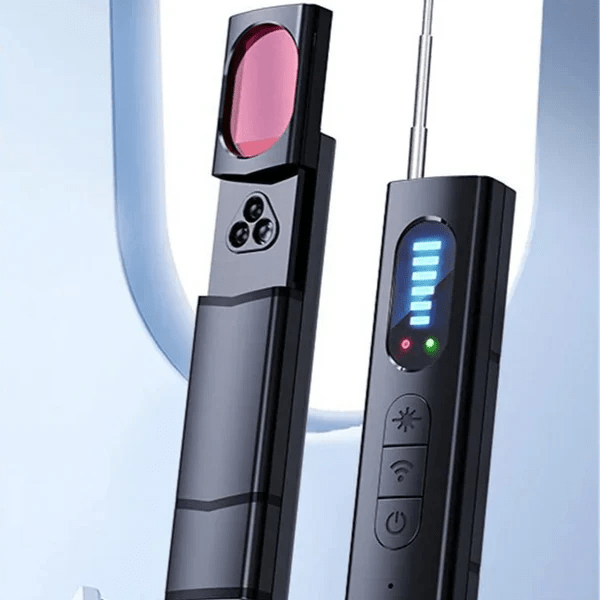
How Hidden Camera Detectors Are Becoming the New Everyday Essential
Share
Introduction
Imagine checking into a hotel, Airbnb, or using a public changing room and wondering: "Am I really alone?"
It’s not paranoia—it’s reality. Hidden cameras and spy devices are more common than we’d like to believe. And in today’s digital age, privacy breaches aren’t just possible—they’re probable.
Enter the Hidden Camera Detector and RF Signal Scanner—your personal bodyguard in a compact, tech-savvy form.
But what is it, how does it work, and who really needs one?
Let’s dive into the world of hidden surveillance—and how you can take back your privacy.
What Is a Hidden Camera Detector?
A hidden camera detector is a portable, handheld device designed to detect:
- Spy cameras (wired or wireless)
- GPS trackers
- Audio bugs
- WiFi-enabled hidden devices
They often work by:
- Detecting infrared lights used in hidden cameras
- Scanning RF (radio frequency) signals
- Locating magnetic fields or lens reflections
The one in the image above combines all these features in one sleek tool—making it a favorite for travelers, businesspeople, and privacy-conscious individuals.
Real-Life Use Cases (That Might Surprise You)
You’d be shocked how many innocent people have been caught in surveillance traps.
Airbnb Guest in Tokyo:
A guest noticed something odd about the smoke detector. With a hidden camera detector, they discovered a tiny camera inside, facing the bed.
Changing Room in a Gym:
Several hidden pinhole cameras were found in a fitness center’s private areas. A gym-goer using a signal scanner flagged unusual activity—and exposed the devices.
Office Espionage:
An employee used a detector to find a hidden microphone planted under the desk during confidential business negotiations.
These aren’t movie plots—they’re real.
Who Needs a Hidden Camera Detector?
- Travelers & Digital Nomads: For hotel rooms, Airbnbs, public restrooms.
- Women & Parents: Protect kids and yourself from hidden surveillance.
- Professionals & Executives: Avoid corporate espionage or meeting leaks.
- Content Creators & Influencers: Prevent unwanted recordings or paparazzi.
- Tenants: Check your rented space for unauthorized surveillance.
In short—everyone who values privacy.
How It Works
This multi-function detector is surprisingly easy to use:
- IR Light Detection Mode: Use the red lens to spot reflections from camera lenses.
- RF Signal Detection: Scan for unusual radio frequencies—common in wireless bugs or GPS trackers.
- Magnetic Field Detection: Helps locate GPS devices often hidden under cars or inside bags.
- Auditory/Visual Alerts: The device beeps and lights up when signals are detected.
All of this packed into a device that fits in your pocket.
The Features You’ll Appreciate
- ✅ 360° Laser Scanning
- ✅ Adjustable sensitivity
- ✅ LED visual indicators
- ✅ Rechargeable battery
- ✅ Silent mode for discretion
- ✅ Strong and durable material
Safety in an Unsafe World
We now live in an age where data = power. Companies spy. People spy. Even apps spy. This little device is your last line of defense.
It gives you back control—without needing to be a tech expert or security professional.
It’s like having your own bodyguard in your handbag or glove compartment.
Peace of Mind for Just a Few Dollars
Let’s face it—privacy tools used to be expensive and complicated. Today, for the cost of a dinner out, you can have a military-grade scanning tool in your hand.
And peace of mind? That’s priceless.
Final Thoughts
We lock our homes. We password-protect our phones. But we often forget to guard our physical privacy.
With the Hidden Camera Detector and RF Signal Scanner, you're taking a proactive step toward safety.
Be empowered. Be aware. Be protected.
FAQs
Q1: Can it detect all kinds of hidden cameras?
It can detect most spy cameras, especially those emitting infrared or RF signals. However, completely passive wired cameras may require visual inspection through the lens detector.
Q2: Is it safe to use on planes or in sensitive areas?
Yes, but use in silent mode to avoid causing disturbances.
Q3: How close do I need to be for detection?
For lens detection, you need to be within a few feet. For RF signals, it depends on the strength—usually within 5-10 meters.
Q4: Does it detect GPS trackers in cars?
Yes. It detects RF signals and magnetic fields, both common in vehicle trackers.
Q5: How long does the battery last?
Most models offer up to 10-12 hours of continuous scanning per charge.
